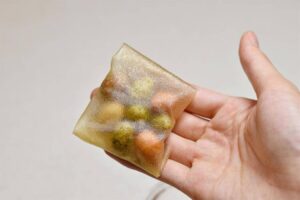I. Introduction
A. Importance of sustainable packaging in today’s business landscape
In today’s business world, there is an increasing emphasis on sustainability and eco-friendly practices. Sustainable packaging plays a crucial role in reducing waste, minimizing environmental impact, and meeting consumer demands for more responsible products. It helps businesses align with their corporate social responsibility goals and improve their brand reputation.
B. Introduction to the concept of Edible Packaging
Edible packaging is an innovative approach to sustainable packaging. Instead of using traditional materials that contribute to waste and pollution, edible packaging offers a unique solution by utilizing edible materials that are safe for consumption. These materials can be made from natural ingredients such as starches, proteins, or seaweed, and are designed to be consumed along with the product they contain. Edible packaging not only reduces waste but also adds an element of novelty and consumer engagement.
II. What is Edible Packaging?
A. Definition and explanation of edible packaging
Edible packaging refers to packaging materials that are safe for consumption and can be eaten along with the product they contain. These materials are typically made from natural ingredients such as plant-based starches, proteins, or even fruits and vegetables. Edible packaging aims to reduce waste and environmental impact by replacing traditional packaging materials that often end up in landfills.
B. Different types and forms of edible packaging materials
Edible packaging can come in various forms, including films, coatings, capsules, and wrappers. Films made from edible materials can be used to wrap or encase products, while coatings can be applied to enhance the shelf life and protect the product. Edible capsules are commonly used for single-serving products, such as condiments or beverages. Wrappers made from edible materials can replace plastic or paper wrappers for items like candy or snacks.
According to Fact.MR’s analysis, the global edible packaging market is valued at US$ 1.11 billion in 2023, projecting to US$ 4.19 billion in the upcoming years.
C. Benefits of using edible packaging
There are several benefits to using edible packaging. Firstly, it reduces waste as the packaging material can be consumed, eliminating the need for disposal. Edible packaging also offers a unique consumer experience, adding a novel and interactive element to the product. Additionally, edible packaging can enhance product freshness and shelf life, as some edible materials have natural antimicrobial properties. Furthermore, it aligns with consumer demands for sustainable and eco-friendly packaging options, improving brand image and customer loyalty.

III. Environmental Impact of Edible Packaging
A. Comparison of traditional packaging materials and their environmental consequences
Traditional packaging materials, such as plastic and paper, have significant environmental consequences. Plastic packaging is derived from fossil fuels and takes hundreds of years to decompose, contributing to pollution and harming wildlife. Paper packaging requires the cutting down of trees, leading to deforestation and loss of habitat. Both materials generate a large amount of waste that ends up in landfills.
B. How edible packaging reduces waste and pollution
Edible packaging offers a sustainable alternative by utilizing natural and edible materials. These materials are biodegradable, meaning they break down naturally and do not contribute to long-lasting pollution. By consuming the packaging along with the product, waste is minimized, and there is no need for disposal. This reduces the burden on landfills and decreases the overall environmental impact.
C. Contribution to a circular economy and sustainable practices
Edible packaging aligns with the principles of a circular economy, where resources are used efficiently and waste is minimized. By using edible materials derived from renewable sources, businesses can contribute to sustainable practices. Edible packaging also encourages consumer participation and responsibility, as it promotes the idea of consuming products in a more conscious and eco-friendly manner. Overall, edible packaging supports the goal of creating a more sustainable and environmentally-friendly business model.
IV. Advantages of Edible Packaging for Businesses
A. Enhanced brand image and customer appeal
By adopting edible packaging, businesses can demonstrate their commitment to sustainability and environmental responsibility. This can enhance their brand image and appeal to eco-conscious consumers who prioritize environmentally-friendly products. Edible packaging showcases a forward-thinking and innovative approach, which can attract and retain customers who value sustainable practices.
B. Differentiation in the market and competitive advantage
In a crowded marketplace, edible packaging can provide businesses with a unique selling point and a competitive advantage. It sets them apart from competitors who still rely on traditional packaging materials. The novelty and interactive nature of edible packaging can attract attention and create a memorable experience for consumers, helping businesses stand out in a saturated market.
C. Meeting consumer demand for sustainable packaging options
Consumer preferences are shifting towards sustainable products and packaging. Edible packaging addresses this demand by offering an eco-friendly alternative to traditional packaging materials. By providing sustainable packaging options, businesses can align with consumer values and cater to their preferences. This can lead to increased customer loyalty and satisfaction, as well as attract new customers who prioritize sustainability.

V. Challenges and Considerations
A. Shelf life and preservation of edible packaging
Edible packaging faces challenges in terms of shelf life and preservation. The edible materials used may have limited durability and can be susceptible to moisture, heat, or other environmental factors. Businesses need to ensure that the packaging remains intact and does not compromise the product’s quality or safety. Proper storage conditions and careful selection of edible materials are essential to maintain the packaging’s integrity.
B. Regulatory and safety considerations
Edible packaging must meet regulatory standards and safety requirements to ensure consumer health and well-being. Businesses need to comply with food safety regulations and obtain necessary certifications for the edible packaging materials they use. It is crucial to conduct thorough testing and risk assessments to ensure that the packaging does not pose any health risks or allergen concerns.
C. Cost implications and scalability
Edible packaging materials may currently be more expensive compared to traditional packaging materials. Businesses need to consider the cost implications of adopting edible packaging and assess its feasibility within their budget. Additionally, scalability can be a challenge as edible packaging may require specialized production processes or sourcing of ingredients. Businesses need to evaluate the availability and cost-effectiveness of edible packaging materials to determine if it can be implemented on a larger scale.
Also Read: From Meat to Plants: The Growing Popularity of Plant-Based Alternatives
VI. Future Outlook and Innovation
A. Trends and advancements in edible packaging technology
The field of edible packaging is continuously evolving, with ongoing research and development to improve its functionality and sustainability. Advancements include the development of edible films with extended shelf life and enhanced barrier properties to protect the product. There is also a focus on incorporating active ingredients, such as antioxidants or antimicrobials, into the edible packaging to further enhance product freshness and safety.
B. Potential applications in various industries
Edible packaging has the potential to be used in various industries beyond food and beverages. It can be applied in pharmaceuticals to provide personalized and dosage-specific packaging. In the personal care industry, it can be used for single-use products like soap or shampoo. Edible packaging can also find applications in the agricultural sector, such as biodegradable seed coatings or plant protection films. The versatility of edible packaging opens up opportunities for innovation in different sectors.
C. Collaboration opportunities for businesses and researchers
The development of edible packaging requires collaboration between businesses and researchers. Businesses can partner with research institutions or startups specializing in sustainable packaging to explore new materials and technologies. Collaboration can also extend to cross-industry partnerships, where businesses from different sectors come together to share knowledge and resources to advance the field of edible packaging. Such collaborations can foster innovation and accelerate the adoption of edible packaging in a wide range of industries.
D. Businesses Involved in the Production
Following is the list of businesses involved in manufacturing
WikiCell Designs Inc.
Safetraces, Inc.
Tate & Lyle Plc.
Tips Corp.
Watson, Inc.
MonoSol, LLC
Internpack
Devro Plc.
Coveris Holdings
Dupont de Nemours and Company
Nagase & Co. Ltd.
Ingredion Inc.
Conclusion
The future of edible packaging looks promising, with ongoing advancements and increasing interest in sustainable packaging solutions. Continued research, collaboration, and innovation will drive the development of more efficient and effective edible packaging materials, opening up new possibilities for businesses across various sectors.



